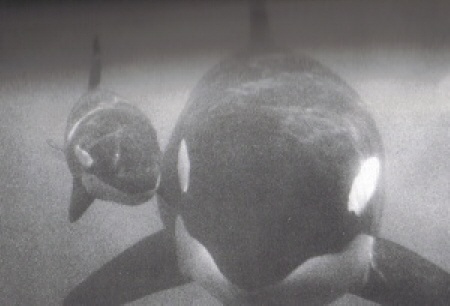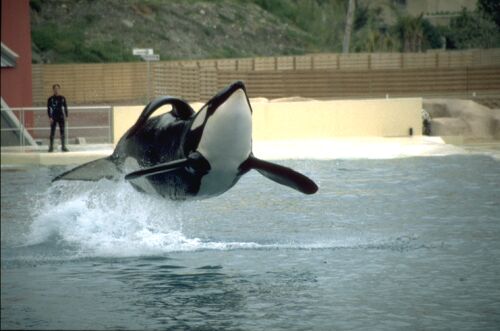

The captive industry was getting exciting. In 1968, when Kianu and Bonnie gave birth to still-born calves, everyone was shocked. No one had ever imagined orcas being BORN in captivity. After that, it was a race to see who could get the orcas to mate, get pregnant, give birth and raise a calf, all under the care of humans and in tanks that were, unknown to them at the time, completely inadequate to raise a calf in.
While this race went on (unsuccessfully), captors had to find another way to keep the orca stock sustained. When the 1970s saw Canada and the USA shut down their captures and vow to protect their orcas from captivity, the orca-hunters had to look outside the box.
In 1972, an orca was captured in Japan, and named Zero. He lived in Kamogawa Sea World, but he was sort of a fluke, considering he died, sadly, 15 days later.
After that, captures stayed within Canada and the USA. Until the USA, and soon after Canada, decided that enough was enough. They weren't even sure what kind of a long-term effect this could have-and were they willing to risk it? No. They stopped the captures. And then the marine parks had to look for countries willing to give away orcas...and with orcas to give!
Before I continue, I must mention two instances that helped bring around the cancelation of orca captures in North America. First of all, remember the four orca calves that were slit and weighted and thrown in the ocean? Well, a fishing trawler dragged up three of them. He dumped them on a beach in front of a reporter. The public went ballistic. Years later, the park involved settled out of court by promising not to capture again in that area. Another time, debates about allowing orca captures were going on, when a group of transients were captured right outside their window! The public was furious; public pressure became so great, the orcas were freed. Two were held for 'scientific purposes'. They had satellite packs placed on their dorsal fins which were supposed to fall off after collecting information. However, this invasive technique wasn't fool-proof; ten days later, the packs were gone, but the metal nuts were still in the orca's fins. Possibly, the two, a mother-and-son pair, tore them off each other. Named Flores and Pender, the two became easily recognizable by their scarred and distinctive fins, and they have returned to normal transient behavior.
So the marine park business began to look for more countries.
They found two countries, actually. Iceland would become the hot spot for killer whale captures, with Japan biting at its heels for second.
In October 1976, a year after the last BC capture, Iceland started its business. 3 whales were captured-Kim was sent to Marineland France, where he lived for 5 and a half years, while Kenau and Gudrun went to Sea World Florida, where they became very well-known whales!
The next year saw the first orca born live into captivity. Corky2 (remember her?) had mated with Orky2 and unbeknownst to anyone, had become pregnant. Imagine the trainers' surprise when she gave birth to a little male calf! Everyone went beserk trying to keep the calf healthy, but the tank was so inadequate a shape to raise a calf in, that despite Corky's best attempts, the calf died 18 days later.
The same year, a little Miracle came into the lives of BC residents.
In 1977, a fisherman found a small orca in a bay south of Campbell River. When help arrived, they discovered a year-old female calf who had been shot, caught in boat propellors, infected, and was dying of starvation. Taken back to a hotel famous for its salt-water pool, she was nursed tentatively back to health. Later, named Miracle because of her miraculous recovery, she was sent to Sealand of the Pacific.
Miracle became best friends with a seal named Shadow. She also became friends with everyone else. Observers said she was more like a big puppy than a whale. She'd come over and play with people's hair, their shoes, their feet...she especially loved divers. When divers got in the water, Miracle went beserk. She'd play with them so much they sometimes had to get out for their own safety. She took to ripping holes in the nets because she knew divers would have to go down to fix them.
The nets that held Miracle weren't fool-proof. While some people pointed this out, Sealand officials didn't think it was dangerous. They said it was a fluke when Shadow drowned in between the nets.
Unfortunately, after 4 and half years of being "Miracle-The Baby Killer Whale", the miraculous Miracle drowned in the nets making one of her holes in 1981.
Meanwhile, while the Miracle saga went on, another capture, much larger this time, happened in Iceland. 6 orcas were taken, none of which are alive today. A year later, 1978, Corky2 gave birth to the second live-born calf in captivity. This calf, born on Halloween and nicknamed 'Spooky', also died of starvation, 11 days after birth.

The same year, two more captures happened in Iceland, taking a total of 8 orcas, two of which are living today. In 1979, the first major capture took place in Japan, taking another 6 orcas. Of the six, only one survived longer than 5 months. 1979 also brought another 5 orcas out of Iceland, as well as another attempt at breeding: in Japan, at Kamogawa Sea World, a still-born calf was born.
The next year saw Corky2's third calf, her first still-birth.
1980 prompted yet another Iceland capture, taking 5 Icelandic orcas, and 6 more the next year. 1982 brought three orcas out of Japan. One of these, Benkei3, was sent to a 'private home' in Japan, where he died a year later. Another one of the orcas, Sacchi, gave birth to a male calf when she was taken to Enoshima Marineland. It died ten days later. A month after Sacchi's calf, Corky2 had her fourth calf. This little female, named Kiva, would be her longest-lived one yet. Kiva, despite attempts by trainers to save her, died 46 days later, the longest-lived calf born into captivity yet.
Five more orcas were taken out of Iceland that year, and in the next 2 years, 8 more.
July 22, 1985, Corky2 gave birth AGAIN. This calf would become her second longest-lived. It died a month later. The same year, two orcas were captured from Japan, and one from a new destination, Argentina.
Then, a few months after Corky2's calf died, on September 26, 1985, captive orca history was made. Katina, a female orca captured from Iceland in 1978, gave birth to a female calf at Sea World Florida.
This young calf, named Kalina, survived past Corky's calve's records. She passed a month, she passed 46 days....she passed a year! This miraculous little girl, conceived, born, and raised in a human environment, survived. She is currently a mother herself, and will be 20 this September!
But the birth was a tentative success. Was this a freak accident? To be sure, captures continued.
But success became bigger and bigger in the captive breeding programs. In 1989, the last orca capture took place in Iceland. In 1992, Argentina took their last orca. And in 1997, Japan took their last ones.
Sadly, in 2003, to much outrage and disgust, another capture took place, this time in Russian waters. One juvenile orca died in the capture, while the female who was taken died a 28 days later.
Since we have started keeping orcas captive, many have died at our hands. Obviously many died at our hands before, too, considering 25% of the orcas captured in North America had bullet wounds!

35 orcas were taken from USA waters. One of them, Lolita, also known as Tokitae, is alive. 10 orcas also died during the captures, bringing the total of dead orcas from these captures up to 45, more than J and K pods put together. And these are the orcas we KNEW about. Many orcas have died without anyone knowing. 3 more were held for a while and then released-or they escaped!
22 orcas were taken from Canadian waters. One of them is also alive, the infamous Corky2, currently residing at SeaWorld California. 1 orca died during the captures. Five more were captured, held for a while, and then released.
According to data from the Japanese Fisheries Agency, 63 orcas have been captured from Japan. We know of 18 of these, three of which are alive now: Nami-Chan, Asuka, and Ku. This means the rest of those 63 orcas have been captured and died without anyone realizing it! Two orcas were also held for a while and then released in Japan.
53 orcas were taken from Icelandic waters. Of these, 10 are alive: Ulises, Nootka5, Kandu7, Kiska, Kasatka, Katina, Tillikum, Kim2, Freya and Thor. Three were held in captivity for a bit and then released.
4 orcas have been taken from Argentina. One of these, Kshamenk, is still alive. One orca also died in Argentinean captures.
Finally, in Russia, 1 orca has been captured. Another died during the capture. The orca who was taken died 28 days later.
On a more successful note, since Kianu and Bonnie's first calves in 1968, 74 orcas have been born into captivity. Of these, 26 are still alive-the majority of orcas in captivity.
Although its great that orcas are being bred in captivity instead of captured, it does not change the fact that literally hundreds of orcas died during the captures. Including 24 pregnancies that did not result in a living calf, more than 223 orcas have died as a result of these captures.